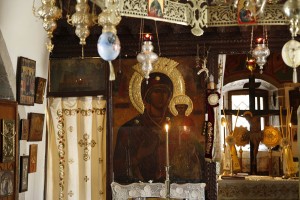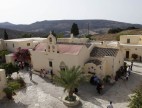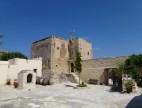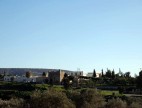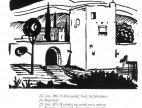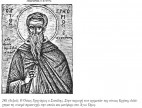Holy Monastery of Odegetria
The monastery of Odegetria [All-Holy Virgin ‘She who leads the Way’] is located to the southwest of the sierra of Asterousia between the settlement of Listaro and the bay of Kaloi Limenes in an area with a continuous monastic presence for centuries. Even though the catholicon of the monastery has mural paintings of the 14th century, a fact which shows that the space was in use from this period, the first written references date to the 16th century. During the Turkish occupation, the monastery took an active part in the Cretan revolutions of the 19th century with monk Ioasaph, also known as Xopateras, a prominent figure in the revolution of 1821, with the result that it was sacked in 1828 and 1866. Despite all this, the monastery was reestablished and continues its unceasing spiritual offering to the surrounding society of Messara to our days. The building complex has a purely fort-like character, as is seen from the tower that rises in the northwest corner of the compound. The central gate of the compound belongs to the older part of the monastery and bears the date 1568. The old olive-press still preserves its 17th–18th century equipment intact. The majority of the individual buildings date to the 18th and 19th centuries, such as the refectory of 1782, while the bakery and abbey date to the 20th century. The twin-naved catholicon is the result of successive interpolations to a single-nave church of the 14th century, the present south aisle. To this original church was added the north aisle, at a later date, dedicated to the Apostles Peter and Paul, and the south to St. Fanourios from which only the outline of the masonry survives today. The cross-vaulted narthex, whose south section was demolished at an unknown date, was added, probably in the middle of the 14th century. The narthex was illustrated with wall paintings of remarkable art, also of the middle of the 14th century, among which stand out two scenes from the life of Paul of Thebes and St. Anthony on the northern wall, as well as sixteen surviving stanzas from the Akathist Hymn. The representation of the donor, monk Gregory, along with other monks, who are being blessed by Christ Pantocrator, in one of the stanzas in the narthex, is worthy of note. As has been mentioned already, the foundations of the aisle of St. Fanourios can be discerned in the south side of the church, in the interior of which the 1602 tomb of Alouzios Tribezanos, probably a notable of the area, is preserved. Particular reference should be made to the four masterpieces –as they have been termed– icons of the great painter of the Cretan School, Angelos, who created them for the altar screen of the church. Among them, the icon of the Embrace of the Leaders of the Apostles, Peter and Paul, an iconographic type which was created by Angelos and constituted a symbolic representation of the reconciliation of the Christian churches of the East and West, stands out. The monastery with its continuous operation through the centuries added other smaller monasteries to its jurisdiction while, in parallel, other dependencies and churches were founded, such as St. Anthony at Agiofaraggo and the All-Holy Virgin at Martsalo, in whose adjacent carved cell saints Parthenios and Eumenios lived as ascetics for some time. Close to the monastery of Odegetria, one of the most important dependencies, is the monastery of Saints Eutychios and Eutychianos, ruined today, in the location of “Agious.” The church of the two saints of the local church was founded by St. John the Xenos [‘The Foreigner’], one of the most important figures of Cretan monasticism who was active earlier during the 11th century. Only a section of the ruined church is preserved today from the complex, in a late rebuilding of the years of the Venetian occupation, a period to which the surviving funereal monument-arcosolium as well as the adjacent cavernous chapel belong.

